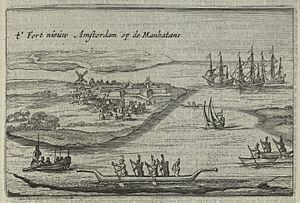Lenape canoes facts for kids
Lenape canoes were special boats made by the Lenape people. These canoes were dugout canoes, meaning they were carved out of a single tree trunk. The Lenape lived in a region called Lenapehoking, which included parts of modern-day New Jersey, Pennsylvania, Delaware, and New York.
The main tree used for these canoes was the American tulip tree, which the Lenape called mùxulhemënshi (meaning "tree from which canoes are made"). Other strong trees like elm, white oak, American chestnut, or red cedar were also used. It's important to know that the Lenape in this area did not use canoes made from birch bark.
How Lenape Canoes Were Made
Most Lenape canoes were built for traveling on calm waters. This included rivers, lakes, and protected harbor areas. They came in different sizes. A larger type might have been called mahelo, while a smaller one was called amochol.
Some old drawings from early Dutch explorers show larger canoes. These drawings sometimes show special extensions at the front and back of the canoe. These might have been used to tie up the boats. However, these old pictures might not be perfectly accurate.
Lenape canoes were similar to the mishoon dugouts used by Native American groups in southern New England. One explorer, Peter Lindeström, even wrote about a special double-hulled canoe. This was like a catamaran, which is a boat with two hulls. He said these larger canoes could travel long distances, even to places like New England or Virginia.
Lenape Canoes and Early European Settlers
When European explorers first arrived, they met the Lenape people in their canoes. For example, Giovanni da Verrazzano in 1524 and Henry Hudson in 1609 both saw many Lenape canoes. About 30 canoes met Hudson in New York Bay.
European settlers soon realized how useful these canoes were. They started to copy the designs of both dugout and birch bark canoes for their own travel and trade.
In the early 1700s, a man named Robert Durham created a new type of boat. It was called the Durham boat. This boat was based on Native American canoe designs. It was first used to carry heavy iron down Scotts Creek to Philadelphia. The Durham boat became very famous later. It was used by George Washington and his army when they crossed the Delaware River in 1776 during the American Revolutionary War.
Lenape Canoe Legacy Today
Today, you can still see examples of Lenape canoes and learn about their history.
- A preserved canoe is at the National Museum of the American Indian in Washington, D.C. It was found in the Hackensack River.
- The museum also has a canoe paddle from New Jersey that belonged to the Lenape.
- The Bergen County Historical Society also says it has an old Native American canoe from the Hackensack area.
- Another possible Native American canoe is at the American Museum of Natural History in New York City. It was found in 1906 on Manhattan's Cherry Street. However, some experts think it might be too new to be from the Lenape time.
- A dugout canoe found in 1957 at Wallenpaupack Creek is on display at the Wallenpaupack Historical Society. But it is likely too new to be of Native American origin.
The legacy of Lenape canoes is still celebrated today:
- In 1996, a Lenapehoking Festival pow wow at Sandy Hook, New Jersey, included a canoe race. It started at Oyster Point in Red Bank, New Jersey.
- Since 2002, the Lenape Nation of Pennsylvania has held a special event every four years. It's called the Rising Nation River Journey. People travel by canoe along the Delaware River. This journey remembers the Treaty of Shackamaxon and helps raise awareness for the Lenape Nation.
- In New York City, the Whitehall Crossing is a permanent art display at the Staten Island Ferry Whitehall Terminal. It features stylized benches that look like canoes. This artwork, created in 2005, celebrates the history of Lenape canoes.
- In 2019, the Bronx River Alliance held a living history canoe ride. This event also honored the heritage of Lenape canoes.


